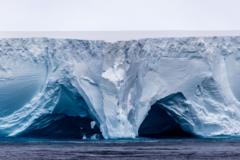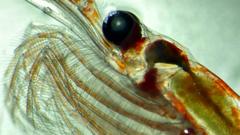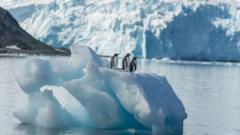Experts warn of potential ecological impacts from the drifting iceberg, A23a, as it approaches the wildlife-rich island.
Giant Iceberg Looms Over South Georgia: Threat to Wildlife Emerges

Giant Iceberg Looms Over South Georgia: Threat to Wildlife Emerges
A massive iceberg on a collision course with South Georgia could jeopardize local penguin and seal populations.
The world's largest iceberg, known as A23a, is hurtling towards South Georgia, a remote British territory teeming with wildlife, putting local penguins and seals at significant risk. Currently situated 173 miles (280 km) away, the colossal iceberg is navigating its way north from Antarctica and is anticipated to ground in the area soon. Past occurrences involving large icebergs have resulted in devastating consequences for the local fauna, with countless seals and birds perishing when similar icebergs obstructed their feeding habitats.
"I would be extraordinarily happy if it just completely missed us," remarked Simon Wallace, a sea captain operating from the South Georgia government vessel Pharos, underscoring the iceberg's unpredictable and dangerous nature. Meanwhile, scientists, fishermen, and sailors around the globe are closely monitoring its trajectory using satellite imagery.
A23a is one of the oldest icebergs known to mankind, having calved from the Filchner Ice Shelf in Antarctica all the way back in 1986. It became caught in a vortex on the ocean floor but broke free in December, now racing toward its inevitable fate. The iceberg, which originally covered over 3,900 square kilometers, has reduced to around 3,500 square kilometers—slightly smaller than England's Cornwall—as it succumbs to the warming waters that erode its towering cliffs, which reach heights of 1,312 ft (400 m).
While past icebergs have impacted wildlife around South Georgia, marine ecologist Mark Belchier noted that the region is accustomed to these threats. In 2004, another massive iceberg claimed the lives of numerous seal and penguin chicks by blocking access to food sources. He emphasizes that the area's fisheries and wildlife have a remarkable ability to adapt.
The sailors and fishermen working the waters near South Georgia are increasingly contending with icebergs. Earlier this year, fishermen faced fears when another significant iceberg, A76, approached dangerously close to grounding. Andrew Newman, a representative from a local fishing company, explained that surviving around icebergs is becoming a routine challenge. "Those pieces basically cover the island—we have to work our way through it," he stated.
Experts note that climate change is not the direct cause of A23a's calving, yet the phenomenon of giant icebergs breaking away from Antarctica is anticipated to increase as the ice sheets become less stable due to rising temperatures. Nonetheless, A23a presents a unique opportunity for researchers. A team aboard the British Antarctic Survey's Sir David Attenborough vessel successfully gathered water samples from the iceberg, which will provide insights into the effects of meltwater on the carbon cycle in the Southern Ocean. This water is rich in nutrients and phytoplankton, and its release may aid in sequestering carbon dioxide, thereby contributing to climate change mitigation.
As A23a approaches South Georgia, its looming presence stands as a stark reminder of how swiftly nature can shift and the ecological consequences that may follow. The iceberg's unpredictable path suggests that every passing moment carries significance for the wildlife and scientists alike.
"I would be extraordinarily happy if it just completely missed us," remarked Simon Wallace, a sea captain operating from the South Georgia government vessel Pharos, underscoring the iceberg's unpredictable and dangerous nature. Meanwhile, scientists, fishermen, and sailors around the globe are closely monitoring its trajectory using satellite imagery.
A23a is one of the oldest icebergs known to mankind, having calved from the Filchner Ice Shelf in Antarctica all the way back in 1986. It became caught in a vortex on the ocean floor but broke free in December, now racing toward its inevitable fate. The iceberg, which originally covered over 3,900 square kilometers, has reduced to around 3,500 square kilometers—slightly smaller than England's Cornwall—as it succumbs to the warming waters that erode its towering cliffs, which reach heights of 1,312 ft (400 m).
While past icebergs have impacted wildlife around South Georgia, marine ecologist Mark Belchier noted that the region is accustomed to these threats. In 2004, another massive iceberg claimed the lives of numerous seal and penguin chicks by blocking access to food sources. He emphasizes that the area's fisheries and wildlife have a remarkable ability to adapt.
The sailors and fishermen working the waters near South Georgia are increasingly contending with icebergs. Earlier this year, fishermen faced fears when another significant iceberg, A76, approached dangerously close to grounding. Andrew Newman, a representative from a local fishing company, explained that surviving around icebergs is becoming a routine challenge. "Those pieces basically cover the island—we have to work our way through it," he stated.
Experts note that climate change is not the direct cause of A23a's calving, yet the phenomenon of giant icebergs breaking away from Antarctica is anticipated to increase as the ice sheets become less stable due to rising temperatures. Nonetheless, A23a presents a unique opportunity for researchers. A team aboard the British Antarctic Survey's Sir David Attenborough vessel successfully gathered water samples from the iceberg, which will provide insights into the effects of meltwater on the carbon cycle in the Southern Ocean. This water is rich in nutrients and phytoplankton, and its release may aid in sequestering carbon dioxide, thereby contributing to climate change mitigation.
As A23a approaches South Georgia, its looming presence stands as a stark reminder of how swiftly nature can shift and the ecological consequences that may follow. The iceberg's unpredictable path suggests that every passing moment carries significance for the wildlife and scientists alike.






















